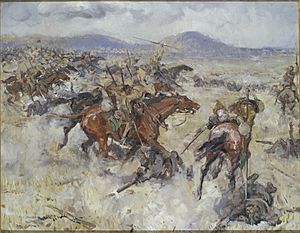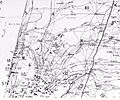Capture of Afulah and Beisan facts for kids
Quick facts for kids Capture of Afula and Beisan |
|||||||
|---|---|---|---|---|---|---|---|
| Part of the Middle Eastern theatre of World War I | |||||||
 6,000 Ottoman prisoners at Beisan receiving rations on 24 September with commander of 16th Division seated on right wearing white arm bands |
|||||||
|
|||||||
| Belligerents | |||||||
| Commanders and leaders | |||||||
| Units involved | |||||||
| Egyptian Expeditionary Force Desert Mounted Corps 4th Cavalry Division |
|
||||||
The Capture of Afula and Beisan happened on September 20, 1918. It was a key part of the Battle of Megiddo during the final months of World War I in the Middle East. During this battle, a group of mounted soldiers called the Desert Mounted Corps attacked and captured two important towns: Afula and Beisan. These towns were far behind the enemy's front lines, about 40 to 50 miles (64 to 80 km) away.
Afula was a major transport hub in the middle of the Esdraelon Plain (also known as the Jezreel Valley). Beisan was on the eastern edge of the plain, close to the Jordan River. Capturing these towns was very important for cutting off the enemy's escape routes.
Contents
A Big Plan: The Battle of Megiddo
The Battle of Megiddo was a huge plan by the British Empire's forces, led by General Edmund Allenby. The goal was to defeat the Ottoman (Turkish) and German armies in the region.
How the Attack Started
On September 19, 1918, British infantry (foot soldiers) began attacking the Ottoman front lines. These lines stretched from the Mediterranean Sea into the hills. The attacks quickly broke through the Ottoman defenses. This created a big gap for the cavalry (mounted soldiers) to ride through.
Cavalry's Fast Ride
The Desert Mounted Corps, which included the 4th and 5th Cavalry Divisions, rode quickly through this gap. Their mission was to get behind the Ottoman armies. They aimed to cut off their supply lines and escape routes across the Esdraelon Plain.
The Journey to Afula and Beisan
The cavalry's journey was long and fast.
Through the Passes
On the night of September 19-20, the cavalry crossed the Mount Carmel Range through two mountain passes. The 4th Cavalry Division took the southern pass, called the Musmus Pass. Their main target was Afula.
Surprise Attack at Musmus Pass
As the 4th Cavalry Division rode into the Esdraelon Plain on the morning of September 20, they met an enemy force. This force was sent by the Ottoman commander, Otto Liman von Sanders, to block the pass. But the cavalry attacked and captured them before they could get into position.
One group, the 2nd Lancers, charged the Ottoman soldiers. They used their lances (long spears) in a brave attack. They captured many prisoners and cleared the way.
Capturing Afula
Soon after, units from both the 4th and 5th Cavalry Divisions captured Afula. This town was a vital communications center. They found about 75 German and 200 Ottoman prisoners there. They also captured ten locomotives, 50 railway cars, a hospital, and an airfield with three undamaged aircraft. This was a huge success!
On to Beisan
After securing Afula, the 4th Cavalry Division continued its advance. They left Afula at 1:00 PM on September 20, heading towards Beisan. They moved quickly along the main road.
Beisan was captured without a fight between 4:30 PM and 6:00 PM on September 20. The 4th Cavalry Division had traveled about 70 miles (110 km) and fought two battles in just 34 hours. This was an amazing feat for the soldiers and their horses.
Securing the Bridges
A part of the 4th Cavalry Division, the 19th Lancers, rode to Jisr el Mejamie (Mejamie Bridge). This bridge was about 9 miles (14 km) north of Beisan. Their job was to capture the railway bridges over the Jordan and Yarmuk Rivers. They reached the bridge early on September 21. They secured the bridges, which helped cut off the enemy's railway connections.
What Happened Next
The capture of Afula and Beisan was a major blow to the Ottoman and German forces.
Enemy Retreats
The Ottoman and German armies, especially the Seventh and Eighth Armies, were now trapped. They tried to retreat northwards, but they ran right into the waiting British cavalry.
The commander of the Yildirim Army Group, Otto Liman von Sanders, had to retreat from his headquarters in Nazareth. He moved towards Damascus, trying to escape the British advance.
Closing the Gap
The 4th Cavalry Division continued to move south from Beisan along the Jordan River. Their goal was to close a 20-mile (32 km) gap. This gap was the last escape route for the remaining Ottoman soldiers in the hills.
On September 23 and 24, the cavalry successfully attacked several river crossings. They captured thousands of prisoners, including enemy commanders. This completely cut off the remaining Ottoman soldiers.
By the end of September, one Ottoman army was destroyed. The rest of their forces were retreating towards Damascus. Damascus itself was captured on October 1. The fighting continued until the end of October, when a peace agreement was signed.
Images for kids










